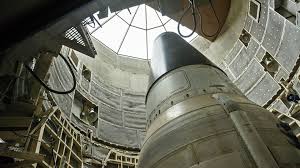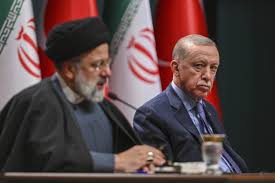A New Arms Race? American Warheads in an Era of Great Power Competition

A Fragile Balance: U.S. Nuclear Strategy Faces a New Age of Multipolar Deterrence
In 2025, the post-Cold War nuclear order is showing signs of deep strain. What once seemed like a gradual de-escalation of nuclear tensions has given way to a rapidly shifting strategic landscape—one defined by the resurgence of great power rivalry, the erosion of arms control regimes, and the global modernization of nuclear arsenals.
Amid this uncertainty, the United States faces a growing dilemma: how to sustain credible deterrence in a world where it may soon have to deter two peer nuclear adversaries simultaneously—Russia and China—in the absence of meaningful arms control.
Resurgent Rivals and the New Strategic Calculus
At the heart of this transformation lies the parallel challenge posed by Russia and China, both of whom are investing heavily in nuclear modernization.
- Russia, already a nuclear superpower, is pursuing next-generation capabilities—including hypersonic glide vehicles, nuclear-powered cruise missiles, and underwater nuclear drones—designed to complicate U.S. missile defense and response planning.
- China, once a modest nuclear power espousing a doctrine of minimal deterrence, is now undergoing a rapid and opaque expansion of its nuclear forces. U.S. intelligence and satellite imagery suggest the construction of hundreds of new missile silos, the maturation of a credible sea-based deterrent, and the development of advanced dual-capable delivery systems.
This shift toward a tripolar nuclear world presents a strategic challenge unprecedented in American history, forcing the U.S. to contemplate deterrence policies aimed at two near-peer nuclear competitors—each with its own strategic calculus and doctrine.
The Uncertain Future of Arms Control
The stability that defined U.S.-Russian nuclear relations in the past decade rested largely on the New START treaty, which limits both countries to 1,550 deployed strategic warheads. But New START is set to expire in February 2026, and the path to renewal or replacement remains fraught.
Russia’s invasion of Ukraine has further complicated negotiations. Moscow has signaled that it will not enter new arms control talks without including other nuclear powers—especially China—a condition Washington has so far declined to meet. With Beijing unwilling to join multilateral arms discussions, the world now faces the prospect of no enforceable limits on the two largest arsenals, potentially triggering an unconstrained arms race.
China’s Opacity and Strategic Ambiguity
Unlike the U.S. and Russia, China does not publish detailed data about the size, composition, or readiness of its nuclear arsenal. This lack of transparency fuels speculation and worst-case planning in Western defense circles.
Without visibility into Chinese doctrine or strategic thresholds, there is a heightened risk of misperception, particularly in moments of crisis. Analysts warn that this opacity could lead to miscalculation or escalation, especially as tensions rise in the Indo-Pacific—a region increasingly central to global power dynamics.
Modernization or Escalation? A Strategic Debate
In response, the United States continues to press forward with its trillion-dollar nuclear modernization program, replacing aging systems with new ICBMs (Sentinel), submarines (Columbia-class), bombers (B-21 Raider), and updated warheads (W87-1, W93). Proponents argue that this is a necessary adaptation to a more dangerous strategic environment.
They claim a modernized force will:
- Strengthen extended deterrence for allies
- Reinforce U.S. credibility amid multiple threats
- Deter adversaries from miscalculated aggression
Yet critics see a dangerous feedback loop emerging. The deployment of more capable U.S. systems, they argue, could be interpreted by Russia and China as escalatory, prompting reciprocal buildups. This action-reaction dynamic risks fueling a new arms race, potentially more volatile and less structured than that of the Cold War.
Regional Flashpoints and the Nuclear Risk Landscape
The shifting nuclear posture is playing out against a backdrop of heightened regional tensions:
- In Eastern Europe, Russia’s war in Ukraine has been accompanied by explicit nuclear threats from Moscow.
- In the Indo-Pacific, U.S.-China tensions over Taiwan and maritime disputes are intensifying.
- In the Middle East, Iran’s nuclear trajectory remains a flashpoint, and the broader region continues to face strategic instability.
Each of these scenarios carries the potential for rapid escalation—and in a multipolar nuclear environment, the path from conventional conflict to nuclear use may be harder to predict and deter.
Strategic Posture in a Multipolar Era
Navigating this new reality requires a careful balance. The U.S. must maintain a deterrent capable of addressing diverse and evolving threats while avoiding measures that unnecessarily escalate competition or undermine strategic stability.
This includes:
- Strengthening communication channels to reduce the risk of miscalculation
- Reengaging in multilateral diplomacy—however challenging
- Exploring crisis management protocols with both Russia and China
- Investing in transparency and confidence-building measures, even in the absence of formal treaties
Conclusion: A Tipping Point for Nuclear Order
As the global nuclear balance shifts toward multipolarity, the future of strategic stability is deeply uncertain. The decisions made in the coming months—on treaties, technology, and doctrine—will shape the international security landscape for decades.
The United States now faces a defining moment: to reinforce deterrence without accelerating the very arms race it seeks to avoid. How well it navigates this treacherous strategic terrain may determine not only its own security, but the broader viability of the post-Cold War nuclear order.
League Manager Editorial Team






Leave a Comment